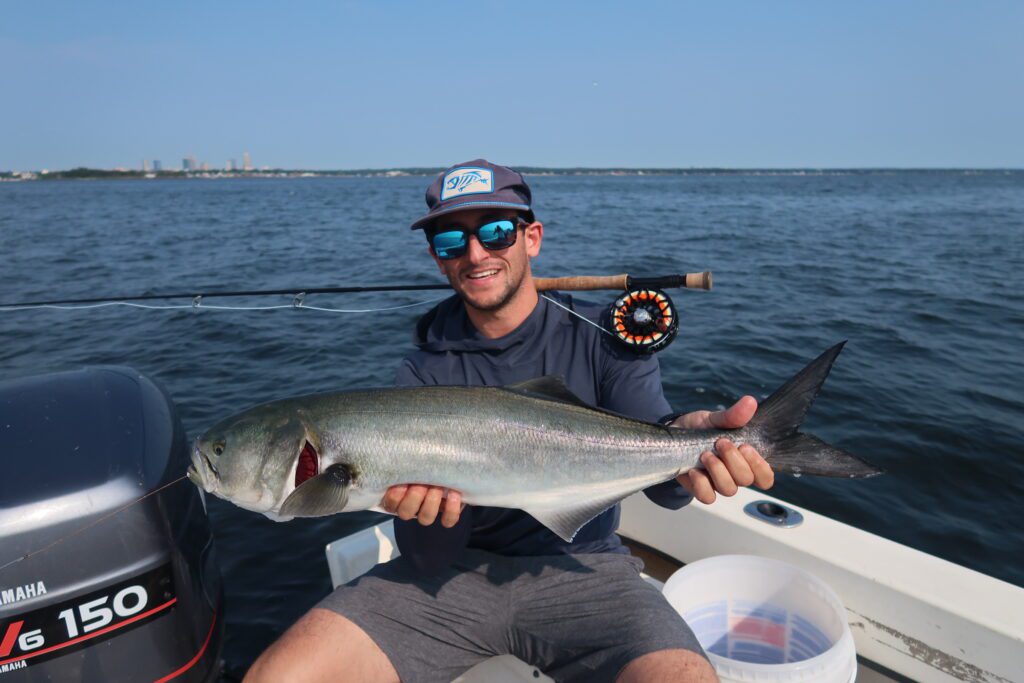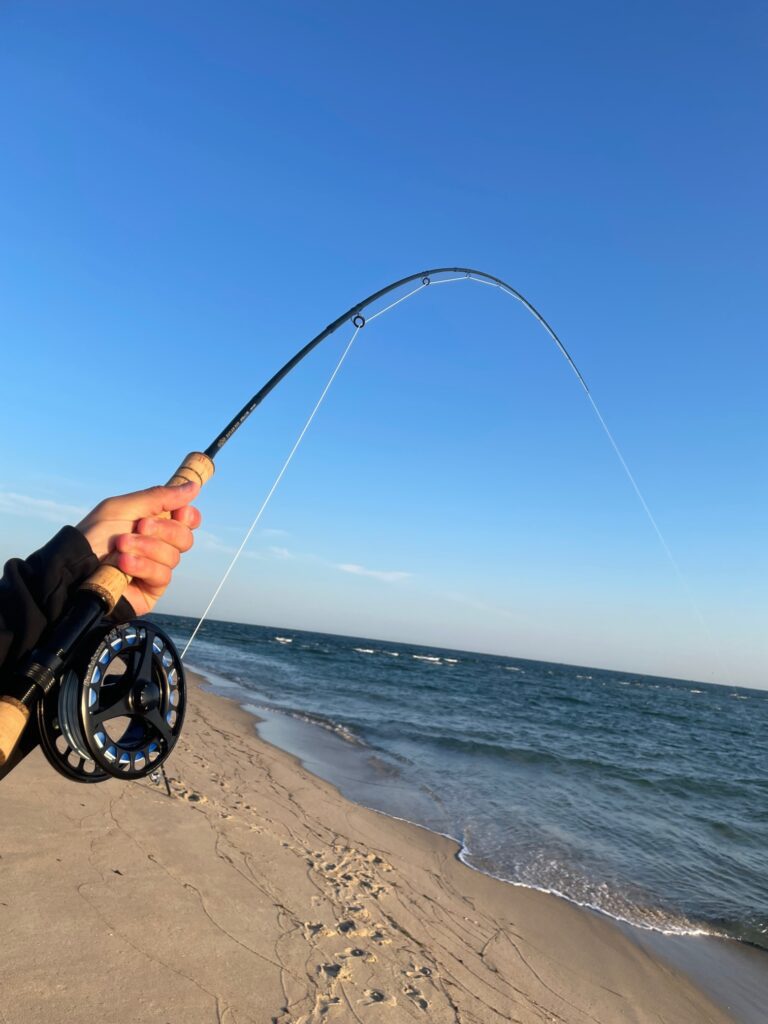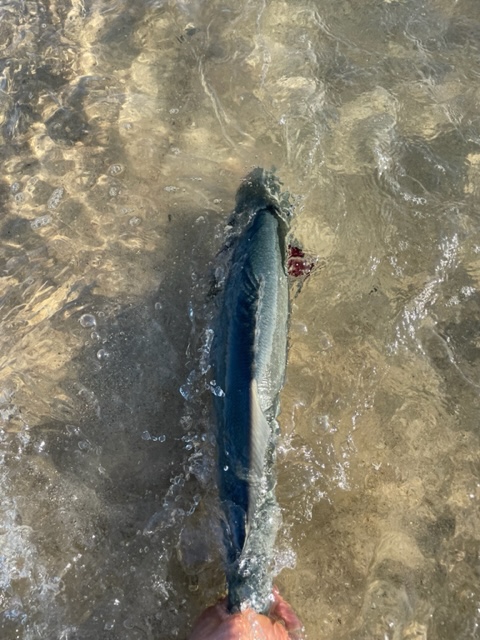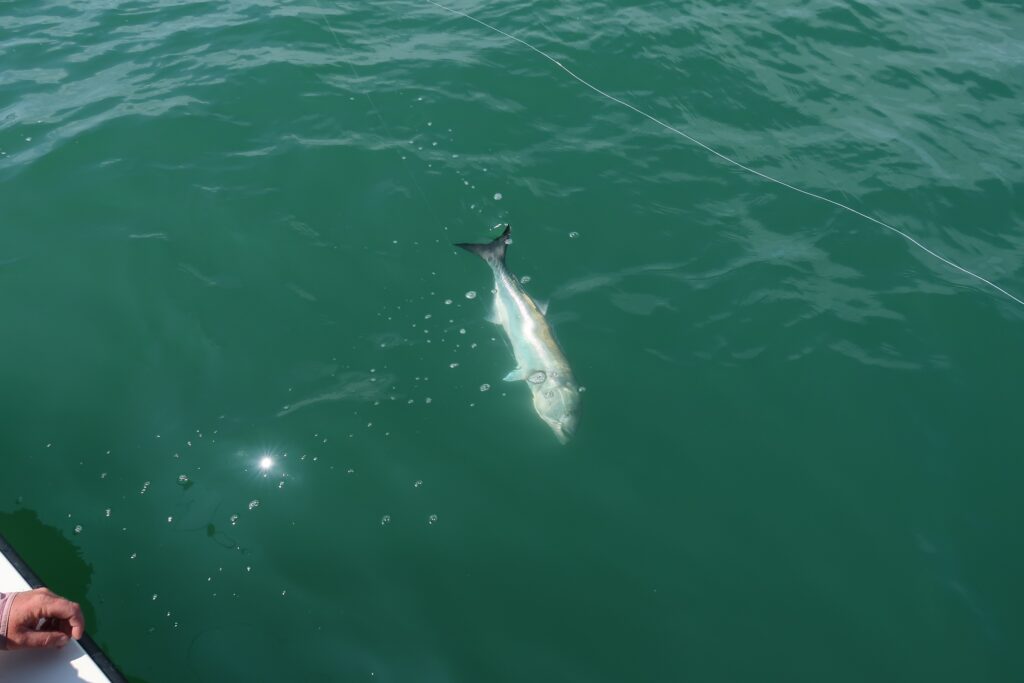
From April until late November you can find bluefish cruising up and down the Northeast. Anglers often refer to these fish as chompers, gators, greasers, and yellow-eyed demons. You can expect to see blues on inshore flats, back bays, and offshore rips. With bright yellow eyes, razor-sharp teeth, and a large sickle tail…. bluefish are the perfect predator. When it comes to fly fishing, there’s nothing quite like the carnage of a bluefish eat.
Timing & Ideal Habitat: There are a few things to look out for when targeting blues on the fly. Bluefish love fast moving water such as rip lines and current edges that create white water. They use these areas to ambush bait such as sand eels, squid, and menhaden. That said, if you can find a school of menhaden on the surface you’ll often see bluefish flying through the air chomping them in half. That said, the most rewarding and exhilarating way to target bluefish is to search for tailing fish. This phenomenon often occurs in June and July. A tailing bluefish will look like a submarine bobbing up and down on top of the water. A tell tale giveaway is a protruding sickle shape fin on top of the water.


Gear: A fast action 9 or 10 weight rod is perfect for taming bluefish due to its tip flexibility and firm backbone which aids in setting the hook and punching flies through wind. As it pertains to reel choice, you’ll want a large arbor reel with a smooth drag as large bluefish will often take you deep into the backing. For fly line, any weight forward taper will do the trick. I prefer alternating between floating and intermediate. My two favorite lines are the Royal Wulff Triangle Taper and the Cortland Cold Water series. In terms of fly selection, I try to avoid bucktail and instead opt for synthetic durable fibers such as SF blend, and craft fur. My favorite patterns include the bobs bangers, surf candy, and SF blend clousers. These flies are fantastic because they’re cheap and easy to tie. Moreover, these patterns easily withstand the sharp teeth and pressure of a big blue.


Tactics: Techniques for catching bluefish are situational. Here’s a guideline.
Tailing bluefish: If your lucky enough to discover the beautiful site of tailing blues, it’s imperative that you make the right cast. If you can make out which way the head of the fish is facing, try to cast a few feet in front of the fish. As soon as the fly hits the water you’ll want to get the attention of the fish by aggressively stripping your fly. If the retrieve doesn’t draw a reaction, make the same cast and throw in a few pauses. This should get the bluefish riled up.
Bluefish on menhaden pods: If you see menhaden schools getting nuked by bluefish, throw a large popper and get aggressive with it. These fish will hone in on your fly and crush it with ill intent. Conversely, if you pull up on a menhaden school and there happily swimming stress free, cast around the edges of the school. Quite often, bluefish will stealthily follow a school of bunker around without giving themselves away. When you cast your fly on the outside of the school, it looks like an outlier or injured baitfish that got separated from the pack. This translates to an easy meal.
Bluefish on rip lines: Inshore rips that create sweeping current and white water are the perfect place for a bluefish to bombard bait. To entice a bluefish in a rip line, cast up current and let the fly swing down. You’ll be surprised when a big blue smashes your fly and begins ripping drag. In order to swing the fly properly ensure that you let the fly move all the way across the current before beginning your retrieve.


Location: Here are a few common spots to target bluefish on a state by state basis
New Jersey: From Mid-April to late June Bluefish invade Sandy Hook & Manasquan inlet in search of adult bunker. These fish are typically cocktail size 2lbs to about 7lbs.
New York: From late April to mid November, the south shore of Long Island, Montauk, and East Hampton hold a large population of giant bluefish. If you put the time in, you’ll have shots at fish to 15lbs. Conducive areas include Shinnecock inlet and Robert Moses.
Connecticut: The bluefish move into Connecticut in mid to late May. The area around the Norwalk islands is known for monsters. Historically, this area holds the largest bluefish in the Long Island Sound.
Massachusetts: Usually, the last week of may and first week of June a large biomass of bluefish invade Cape Cod, Martha’s Vineyard, and Nantucket. The sheer volume of bluefish in Massachusetts is a sight to behold.
